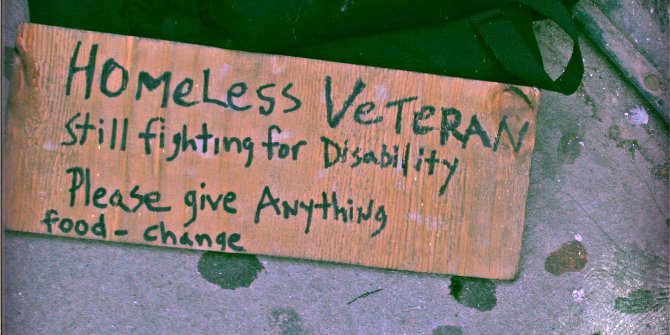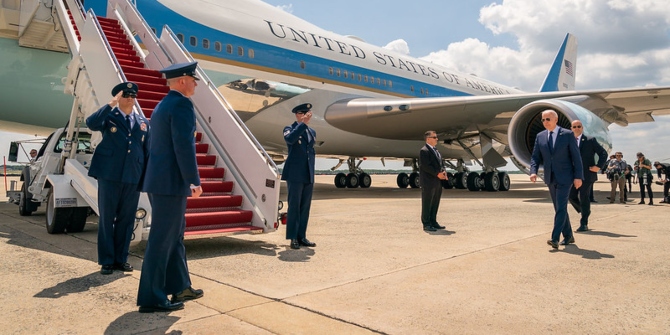 We are now more than a decade on from the release of the Abu Ghraib abuse photos, which led to one of the largest scandals of the War on Terror. While there have been reports and investigations in the decade since, Peter Finn writes that there are still many unanswered questions. He argues that those higher up in the military chain of command, as well as contractors and their companies, still remain unaccountable. In order to bring closure to the victims and their families, a full and frank investigation into abuse by U.S. forces during the War on Terror is still needed.
We are now more than a decade on from the release of the Abu Ghraib abuse photos, which led to one of the largest scandals of the War on Terror. While there have been reports and investigations in the decade since, Peter Finn writes that there are still many unanswered questions. He argues that those higher up in the military chain of command, as well as contractors and their companies, still remain unaccountable. In order to bring closure to the victims and their families, a full and frank investigation into abuse by U.S. forces during the War on Terror is still needed.
Today marks the 11th anniversary of the release of the Abu Ghraib abuse photos by the TV show 60 Minutes. Despite a myriad of reports and investigations, promises to learn from what happened and one of the largest scandals of the War on Terror era, many unanswered questions related to Abu Ghraib persist. Below I review five of the most pressing of these questions.
1) Will anyone in the upper echelons of the chain of command ever be held accountable for the abuse of detainees at Abu Ghraib?
The most senior person to face any punishment for the abuse at Abu Ghraib was Brigadier General Janis Karpinski, who was demoted to colonel. While Karpinski was in charge of detention operations in Iraq and, as such, was certainly culpable, it is hard to believe that those higher up should not also face censure. Meanwhile, the commander of US forces in Iraq at the time the photos were taken, General Ricardo Sanchez, signed off on interrogation techniques that amount to torture but faced no penalty. One fears that those high in the chain of command are unlikely to ever be held accountable. Yet without such accountability flowing upwards, it will be hard for the page to ever truly be turned on the abuse depicted in the photos.
2) Will contractors, or the companies that deployed them, be held accountable for the abuse they perpetrated at Abu Ghraib?
Contractors working for the private military companies CACI and Titan were involved in the abuse of detainees at Abu Ghraib. The evidence to back up this assertion comes from, among other sources, US military investigations, court filings, photos, media stories and personal confessions. Despite this, not a single contractor has been prosecuted for their actions. When reviewing a case with clear photographic evidence the US Department of Justice stated that ‘’’insufficient evidence’’’ was present to pursue the two contractors pictured with a detainee in ‘’’an unauthorized stress position’’’.
In 2012 the successor company to Titan, Engility Holdings, Inc, settled out of court with over 70 detainees to the tune of $5.28 million. This was done to ‘resolve and dismiss’ claims against the company. However, CACI is still aggressively fighting a lawsuit stemming from Abu Ghraib and, despite the money paid by Engility, no public admittance of guilt has been made. As with the previous question, one fears the answer to this one is no. Yet, given the large role that contractors are likely to play in future conflicts, the impunity enjoyed by those working for CACI and Titan is troubling on many levels.
3) Were the techniques utilised at Abu Ghraib honed in Chicago?
Recent revelations published in The Guardian illustrate that a number of the techniques deployed at Guantanamo Bay were honed by Chicago detective Richard Zuley. The techniques, such as “prolonged shackling, family threats” and “demands to implicate others’’, used by Zuley after he was recruited to work at Guantanamo are eerily similar to those utilised by Zuley in the Windy City. Much has been made of the fact that Major General Geoffrey Miller, Zuley’s boss at Guantanamo, was sent to‘Gitmo-ize’ Abu Ghraib during his visit to Iraq in late summer 2003. However, the details revealed by The Guardian lead one to question whether Miller, who apparently thought Zuley was ‘was the greatest thing since sliced bread’, applied insights from Zuley’s work at Guantanamo in Iraq.
4) Will the US government ever be forced to release photos that document abuse elsewhere?
For the past decade the US government has fought the release of photos said to document similar abuse of detainees elsewhere in Iraq and in Afghanistan. In a ruling in late March this year US District Judge Alvin Hellerstein ordered the release of the photos. Hellerstein stated that a number of the images he has seen warrant ‘serious consideration’. The US government has two months to appeal the decision. Given its history of fighting the release of the photos, it would be surprising if the US government did not decide to appeal the decision.
5) Will a full and frank investigation into abuse by US forces during the War on Terror ever take place?
The photos from Abu Ghraib can only be fully understood within their broader context of the War on Terror, where the US has engaged in the systemic abuse of detainees. This abuse has occurred in places as disparate as Cuba, Iraq, Poland, Afghanistan and Diego Garcia. While piecemeal attempts, such as the Senate torture report, have been made at documenting portions of this abuse, surely a full and frank reckoning needs to take place. Such a reckoning should see those at all levels of the chain of command subject to scrutiny and victims of abuse at Abu Ghraib and elsewhere compensated. Until such investigations and compensations take place, the abuses perpetrated over the last decade and a half will continue to operate as open sores that will prevent the War on Terror era from ending and stop victims from gaining closure.
Despite the huge furore that flowed from the release of the abuse photos from Abu Ghraib, many questions remain unanswered. The issues touched on above, along with many others, show little sign of being resolved. Given that more than a decade has passed since the original release of the photos, the lack of clarity and accountability on many issues is tragic.
Featured image credit: Justin (Flickr, CC-BY-NC-SA-2.0)
Please read our comments policy before commenting.
Note: This article gives the views of the author, and not the position of USApp– American Politics and Policy, nor of the London School of Economics.
Shortened URL for this post: http://bit.ly/1Gs09hK
_________________________________
 Peter Finn – Kingston University
Peter Finn – Kingston University
Peter Finn is a lecturer in Politics and PhD candidate at Kingston University. His research is focused on conceptualising the ways that the US and the UK attempt to embed impunity for violations of international law into their national security operations. His main case study is US led detention operations during the Iraq War. His work has been published in Critical Studies on Terrorism, Open Democracy and The Conversation.






